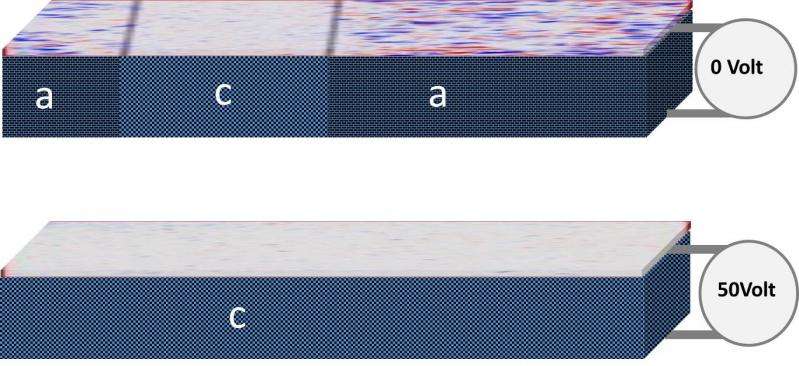New options for spintronic devices: Switching magnetism between 1 and 0 with low voltage near room temperature

Scientists from Paris and Helmholtz-Zentrum Berlin have been able to switch ferromagnetic domains on and off with low voltage in a structure made of two different ferroic materials. The switching works slightly above room temperature. Their results, which are published online in Scientific Reports, might inspire future applications in low-power spintronics, for instance for fast and efficient data storage.
Information can be written as a sequence of bit digits, i.e. "0" and "1". Materials which display ferromagnetism are currently used to handle or store such bits of information in magnetic memories by controlling the magnetization strength or direction of the individual bits via magnetic fields. But the use of magnetic fields goes along with high power consumption. Now, a comparatively low power approach which uses electric fields (voltages) instead to write magnetic information might do the trick, as demonstrated by HZB scientists in collaboration with Lee C. Phillips and his French colleagues.
Sample of two different ferroic materials
Their sample consisted of two different ferroic layers: on a ferroelastic BaTiO3 (BTO) substrate a thin film of ferromagnetic FeRh was grown. Last year, they observed already that a small voltage across the BTO could change magnetic order in the ferromagnetic FeRh film via a strong magnetoelectric coupling between both layers.
Now, they could see much larger effects. "We could switch ferromagnetic states in the FeRh film completely on and off with a low voltage applied to the underlaying BTO", reports Sergio Valencia, the HZB scientist who led the study. With XPEEM imaging at BESSY II they observed the transition between different magnetic orders in the FeRh layer, driven by an electrical field applied across the BTO substrate.
Electric fields, strain, magnetic order and temperature
It works because a low voltage on the BTO substrate deforms its crystal structure via a ferroelastic effect, creating a strain. This strain is transferred to the FeRh film grown on top of the BTO and influences its magnetic order. As physicist Valencia puts it: "By the strain on the BTO substrate we can increase the transition temperature of FeRh, a characteristic temperature which separates antiferromagnetic order from ferromagnetic order. Below this temperature, FeRh is antiferromagnetic (net magnetic moment is zero), above it becomes ferromagnetic. Normally this transition temperature for FeRh is around 90°C, but under strain (through the voltage applied to the BTO substrate) it is shown to rise to ca. 120 °C. To demonstrate this effect, the experiment was conducted at 115 °C, a temperature at which in absence of strain FeRh was observed to be ferromagnetic. When the voltage was applied to the BTO substrate, the strain transferred from BTO to the FeRh increased the temperature needed to have a ferromagnetic order and the FeRh became antiferromagnetic.
Switiching near room temperature
"This is quite relevant. Here we have a structure showing switching effects between two different magnetic states close to room temperature. This is precisely what you need in order to develop room temperature working devices. Moreover, to switch between these two states we use electric fields instead of magnetic fields which consumes less energy. In the near future we aim at doping the FeRh film with palladium to get effects even closer to room temperature." Valencia says.
Journal information: Scientific Reports
Provided by Helmholtz Association of German Research Centres




















